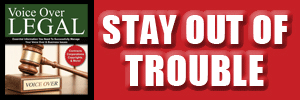|
HOME STUDIO To Improve Your Home Studio Acoustics, Know What Noise To Control - And How  By Dan Lenard By Dan LenardThe Home Studio Master Overlooked by many who are new to voice over and a voice over home studio is the mysterious world of room acoustics. You have two major considerations: 1. Keep outside noise out, or to a minimum.The problem is that few understand what to listen for as unacceptable noise or reflection in a home studio. OUTSIDE COMES IN Ideally, there should be no outside noise. Guess what? Without major investment, which must be justified by significant income, sound "proofing" a voice studio in a home or apartment is next to impossible. There will always be something that leaks through. The variable is what that sound is, and how audible it is compared to your voice. CONTROLLING THE NOISE To keep outside noise out, you need to have a room (or closet) that is far away from outside noise like traffic, airplanes, lawnmowers and leaf blowers - or, is constructed in a place and is surrounded by materials that prevent the "transmission" of outside noise. Concrete is a good example of that material. Inside noise - like washers, dryers, dishwashers, refrigerators and the dreaded HVAC - are actually more controllable. TURN THEM OFF when you record! GET IN THE CLOSET A spare closet is your best choice for a home studio, especially if there are lots of clothes in it, or you can put those in there. Not everyone has a closet like that, but some simple modifications to a small one can render it voice-booth "worthy.” BOUNCING OFF THE WALLS Where I think newcomers - and that includes experienced professionals who have not recorded on their own - have the least knowledge, is sound reflectivity. That is, sound bouncing off the walls and coming back to your microphone. There's a difference between the natural ambiance of a fully furnished room and an empty one, and a quiet booth and sounding like you're in a shower stall. In other words, the "liveliness" of a room. ROOM SIZE CAN MATTER The nature of that reflectivity depends on the size of the room. For instance, a 10 x 10 bedroom converted to a home voice studio can be made to sound like it's much smaller with some simple dampening techniques. Or it can sound like you are recording in a bathroom. You wouldn’t believe how many times I hear audio that sounds like it was recorded in an empty hallway or under someone's desk. The major factor is the material the room is constructed of, and what other surfaces are in the room. Hard surfaces, along with other characteristics that have to do with surface density, play major roles. THE COVER UP You have to cover these surfaces with material that absorbs sound, as opposed to reflect it. There are lots of choices in materials to accomplish that, from commercial sound absorbing foam or special acoustic panels, to moving blankets, or that quilt you inherited from an Aunt. Be resourceful and go for what will be the least investment to experiment with. By that I mean "tuning" your room for the proper sound. However, to determine if you have accomplished the correct ambiance, have someone knowledgeable give your audio a listen. It's a science and it's an art, but the most important factor to master is knowing what it is not supposed to sound like. If you know that, you have a place to start when it comes to evaluating your home studio's sound. ---------------- ABOUT DAN
Dan Lenard is the Home Studio Master, a sought-after voice over home studio consultant, solving problems by phone, email, Skype - and also teaching VoiceOverXtra webinars. He
is co-host of the popular Sunday night Ustream TV show, East-West Audio Body Shop (EWABS), featuring voice industry guests and live answers to home studio problems. And a veteran broadcaster, Lenard is also a busy voice talent. Email: homestudiomaster@verizon.net
EWABS: www.ewabs.com
|
Tell Us What YOU Think!
Please Note: Since we check for spam, there will be a slight delay in the actual posting of your comment.
Comments (3)
Mark
8/19/2012 at 8:39 AM
I have a DIY dedicated recording space in my Tokyo apartment, yet a low-volume but high-pitch whine from the refrigerator on the other side of the thin wall still leaks through the thick layers of sound-blocking material I stuck on both sides of the wall. So I turn off the fridge when recording. I connected the fridge power cord to an extension cords that has an power on-off switch, so I don't need to dig through the fridge contents to get at the power switch inside the refrigerator.
Uncle Roy
8/19/2012 at 8:35 AM
Good one, Dan. I've gotta get some bass trap wedges happening in my 4x4 Whisper Room pronto, plus some Auralex on the walls. That oughtta do it! Thanks!
Mike Harrison
8/18/2012 at 11:13 PM
Good stuff! Great, useful information for those new to recording, Dan.










click for new article alerts